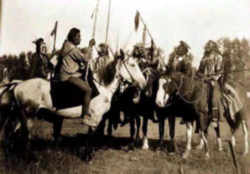


Nevada Early History
First Early Inhabitants of Nevada

Early history examines the archaeological record that tells the story of the first inhabitants of Nevada. Learn about the prehistory and culture of the first early inhabitants, and what lessons it might teach us about the early history of Nevada.
Nevada First Early Inhabitants Timeline
- 230Mil BC The Panthalassa Ocean covered much of what later became the western United States. Sediments later called the Luning Formation were deposited in what later became the mountain ranges of central Nevada. Fossil ichthyosaurs included Shonisaurus popularis.(NH, 6/01, p.22)
- 225Mil BC Icthyosaur fossils first found in 1928 by Prof. Seimon W. Muller of Stanford 150 miles SE of Reno, dated to this time. An inland sea linked to the Pacific and submerged California and Nevada during the Triassic. (SFEC, 4/23/00, p.T10)
- 145Mil BC The seas over Nevada receded. (SFC, 12/2/06, p.A6)
- 112Mil BC - 99Mil BC Most of Nevada was a flood plain and supported dinosaurs including the raptor dromaesaur, sauropods, tyrannosauroids and iguanodonts. (SFC, 12/2/06, p.A6)
- 50Mil BC The collision of the North American and Pacific Farallon plate, began lifting the Sierra Nevada about this time. The Clear Lake basin of California rose above sea level. The rise of the Sierra Nevada continued for another 20 million years. (SSFC, 6/9/02, p.C8)(SSFC, 1/16/11, p.C2)
- 23-5 Million BP Mastadons, mammoths and rhinos roved Nevada during the Miocene. (SFEC, 4/16/00, p.C5)
- 15590 BC Saber tooth cats roamed the hills north of Las Vegas about this time. Fossils of the front legs of such a cat were identified in 2012. (SFC, 12/17/12, p.A5)
- c10,000 BCE Petroglyphs dating to this time were later discovered in the Big Smokey Valley of Nevada, where Lake Tolyabe and Lake Tonopah provided for human habitation. (USDI, 2004)
- 8000 BC In Nevada about this time the Lathrop Wells Cone erupted. It is less than a mile from Yucca Mountain, a site later proposed for the long-term storage of radioactive waste. (Smith., 5/95, p.44)
- 900 BC - Patayan and Anasazi Indians inhabit Colorado River area.
- c0AD The last small lake disappeared from the Death Valley basin about this time. At least 4 lakes covered the valley floor in Earth's history. (SFEC, 1/3/99, p.T5)
- 1200 - Mojave Indians plant crops along river banks.
Early History of Native Americans in Nevada
The Indigenous People of Nevada
The names of the Nevada tribes included the Koso, Paiute, Panamint, Shoshoni, Walapi, Washoe and Ute tribes
Native Americans inhabited the region that is now the state of Nevada thousands of years before Spanish explorers and fur traders began to explore
the area. Archaeological discoveries of bones and ashes in the southern portion of the state reveal that Native peoples lived there more than 20,000
years ago. Cave drawings left by these ancient people can be found in the Valley of Fire State Park near present-day Las Vegas. Baskets, decoys, and
ingenious traps are evidence of the resourcefulness of these early people in a harsh and arid environment.
The Washoe tribe inhabited the Sierra Nevada Mountain Range that forms the border between present-day Nevada and California. They were highly skilled
basket makers and used a dialect that was markedly different from that of the other Nevada Indians. The Paiute lived in northern and southern Nevada.
Both groups depended primarily on hunting, gathering, and fishing for their food.
Much of northeastern region was occupied by the Shoshone. They were part of a much larger group of Native Americans known as the Uto-Aztecan whose
culture spread from present-day Washington State to the borders of Mexico. One of the most famous members of the Nevada Shoshone tribe was Sacajawea
who served as guide and interpreter for Lewis and Clark on their expedition.





